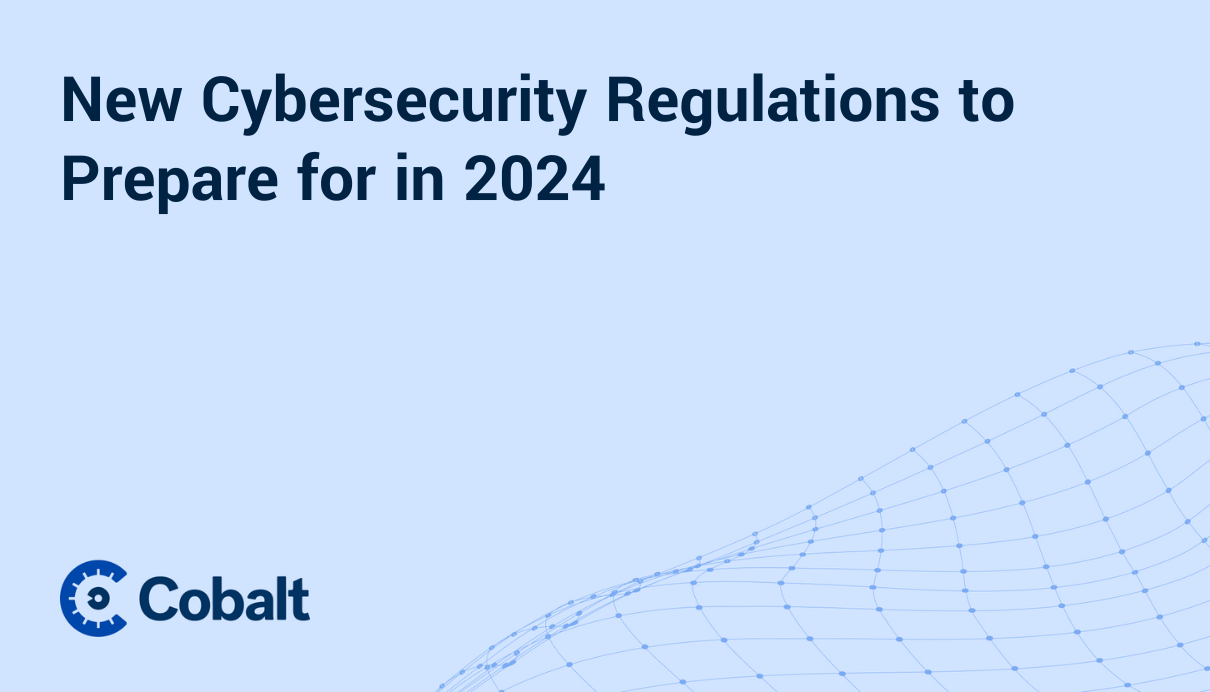The landscape of cybersecurity is transforming thanks to our ever-evolving regulatory environment.
From the data protection mandates of GDPR to the proactive cyber resilience requirements of DORA in the financial sector, and the expansive reach of the NIS 2 Directive across various industries, new regulations are reshaping the cybersecurity strategies of companies worldwide.
In the United States, the SEC's enhanced disclosure requirements are turning cybersecurity governance into a boardroom priority, while state-level laws like CPRA and CCPA in California are setting new benchmarks in consumer data privacy.
Traditionally, enterprise companies have focused on compliance with regulations as a baseline for their cybersecurity strategies. Recent changes in regulatory requirements are compelling businesses to continue to shift their approach from merely meeting compliance standards to adopting a more proactive stance in defense.
For instance, companies in the financial sector are now investing in advanced threat detection systems that go beyond the basic requirements of regulations, illustrating this shift towards a proactive cybersecurity posture.
These regulations, while often originating in specific regions like the EU or the US, have a ripple effect across the globe, influencing international business practices and setting a de facto standard for cybersecurity measures worldwide.
This new paradigm emphasizes not just adherence to rules but a dynamic, offensive strategy in cybersecurity, ensuring organizations are not just compliant but also resilient and prepared against emerging cyber threats. This shift marks a critical change in how public and private entities perceive and manage their cybersecurity risks in response to regulatory pressures.
SEC Disclosure Requirements: Elevating Cybersecurity to a Boardroom Priority
The Securities and Exchange Commission (SEC) has significantly upped the ante for public companies with its enhanced disclosure requirements for cybersecurity risks and incidents. These new rules are not just about ticking compliance boxes. They're reshaping how companies approach cybersecurity at a fundamental level.
With the SEC's mandate for detailed disclosure of cyber risk processes and management strategies, companies are now compelled to integrate cybersecurity into their core business strategies. This shift elevates cybersecurity from a technical issue to a boardroom priority, ensuring that it receives the attention and resources it deserves. This heightened focus on cybersecurity disclosure has led to a surge in demand for cybersecurity experts who can articulate complex security issues to stakeholders, demonstrating the practical implications of the SEC's mandate. Furthermore, it also continues to fuel the cybersecurity talent gap that’s existed for years.
The requirement for transparency in risk management is pushing companies to adopt proactive offensive security measures. It's no longer sufficient to have reactive defenses in place. Companies must now demonstrate a forward-thinking approach to cybersecurity, actively seeking out and mitigating potential threats before they materialize into damaging incidents
This proactive stance is crucial in an environment where cyber threats are increasingly sophisticated and informed by advanced techniques like artificial intelligence and digital risk assessments. The SEC's regulations are driving companies to not only disclose their cybersecurity practices but also to evolve these practices to counter emerging threats effectively.
CPRA/CCPA/GDPR and Emerging State Regulations: A Worldwide Push for Data Privacy
The California Privacy Rights Act (CPRA), California Consumer Privacy Act (CCPA), and the European Union’s General Data Protection Regulation (GDPR) have set significant precedents in data privacy and security regulations. These laws mandate stringent data protection measures, granting consumers greater control over their personal information and imposing heavy penalties for non-compliance.
CPRA and CCPA, for instance, require businesses to disclose their data collection practices, allow consumers to opt out of data selling, and provide rights to access and delete personal information. GDPR, with its global impact, emphasizes consent, data minimization, and the necessity of timely breach notifications.
Following this trend, states like Texas, Florida, and Oregon are implementing similar regulations, reflecting a nationwide movement toward enhanced data privacy and security. Texas, for example, has been strengthening its data breach notification requirements, while Florida's privacy legislation, similar to CCPA, focuses on consumer rights. Oregon’s Consumer Information Protection Act proposes stringent measures for consumer data protection, mirroring aspects of GDPR.
Other states with emerging data protection laws include Virginia, Colorado, Connecticut, and Utah - forcing nearly anyone operating online with U.S. citizen traffic to adhere to these emerging data privacy standards.
DORA: Strengthening Cyber Resilience in the Financial Sector
Following the rapid digital transformation in the European Union's financial sector, the Digital Operational Resilience Act (DORA) was introduced in January 2023 as a critical regulatory response. Aimed at enhancing the digital resilience of financial market participants, DORA addresses the heightened cybersecurity threats and technological disruptions faced by entities like banks, insurance companies, and investment firms.
To comply with DORA, financial institutions are rethinking their operational practices. This includes substantial investments in advanced cybersecurity infrastructure and comprehensive staff training programs to heighten vigilance against evolving digital threats. For instance, banks are now implementing state-of-the-art encryption technologies and conducting regular cybersecurity drills. These drills are designed to simulate a variety of cyberattack scenarios, enabling institutions to test and refine their response strategies. Such proactive measures, mandated by DORA, are elevating cybersecurity standards in the financial sector and could serve as a model for other industries.
DORA's Comprehensive Framework
DORA's framework is designed to ensure that financial institutions can effectively manage and recover from technological disruptions:
- Governance and ICT Risk Management: It mandates robust governance structures and ICT risk management frameworks, requiring entities to have clear policies for managing ICT risks. Read more about cyber GRC.
- Third-Party ICT Provider Contracts: Financial institutions must enforce strict contractual norms with third-party ICT providers, ensuring adherence to high security standards.
- Standardized ICT Incident Reporting: DORA introduces uniform reporting procedures for significant ICT incidents, facilitating a coordinated response across the EU's financial sector.
- Regular ICT System Testing: The regulation requires periodic testing of ICT systems, including penetration testing, to ensure operational stability and preparedness against cyber threats.
- Effective Detection and Response: Financial organizations are expected to have systems for detecting and responding to ICT-related disruptions, including network isolation capabilities during cyber-attacks.
Emerging technologies like AI and blockchain are playing a crucial role in enabling these institutions to meet DORA's stringent requirements, offering solutions for risk assessment, real-time monitoring, and secure data management.
NIS 2 Directive: Expanding and Strengthening EU Cybersecurity Measures
In response to the dynamic digital landscape and escalating cybersecurity threats, the European Union has introduced the Network and Information Security (NIS) 2 Directive. Building on the original NIS Directive from 2016, NIS 2 broadens its scope and strengthens obligations to enhance digital resilience across various sectors.
EU states are required to enact NIS 2 into law by October 17, 2024, marking a significant step in the EU's commitment to a secure digital future. By standardizing cybersecurity practices across member states, it aims to foster a safer digital environment for businesses and consumers alike.
Key Features of the NIS 2 Directive
- Expanded Scope: NIS 2 extends its reach to include a wider range of entities, such as operators in energy, banking, health, water supply, chemical manufacturing, food processing, waste management, and even social network providers. This expansion reflects the recognition that digital threats are not confined to traditional sectors.
- Stricter Protocols and Accountability: The Directive imposes more stringent cybersecurity protocols and holds individuals in leadership roles accountable for lapses. Enhanced supervisory measures and substantial fines for non-compliance ensure rigorous adherence to the new standards.
- Proactive Risk Management: Organizations are mandated to conduct periodic risk assessments and address vulnerabilities with a multi-layered defense strategy. This proactive approach is crucial for fortifying defenses against both physical and digital threats.
- Robust Incident Response: NIS 2 emphasizes the importance of well-equipped and regularly trained incident response teams, ensuring organizations are not just compliant but truly fortified against cybersecurity threats.
- Stringent Reporting Requirements: The Directive prescribes detailed reporting protocols for swift response and transparent communication following security incidents. Entities must issue early warnings, provide comprehensive incident notifications, and submit detailed reports within stipulated timelines.
While both GDPR and NIS 2 are EU legislative instruments focusing on digital security and privacy, they target different aspects. GDPR concentrates on protecting individual rights and personal data privacy. At the same time, NIS 2 is dedicated to safeguarding digital infrastructures and ensuring high cybersecurity standards for essential services and key digital service providers.
NIS 2 also opens avenues for cross-sector collaboration in cybersecurity. By bringing diverse industries under a common regulatory framework, it encourages the sharing of best practices and joint initiatives to combat cyber threats.
Preparing for NIS 2 Compliance
The transition period until October 2024 provides EU member states and businesses with time to strengthen their cybersecurity frameworks. For organizations already familiar with ISO standards, compliance with NIS 2 may involve enhancing existing controls rather than starting anew. CISO teams can use this period to secure resources and budget for necessary infrastructure and procedural changes, ensuring a smooth adaptation to the new regulations.
Regulatory Compliance as a Catalyst for Cybersecurity Innovation
The evolving regulatory landscape in cybersecurity is not just reshaping compliance strategies but is also catalyzing a fundamental shift in the corporate mindset toward cybersecurity. As regulations become more stringent and encompassing, they are inadvertently fostering a culture where cybersecurity is ingrained as a core business function rather than an afterthought or a mere compliance requirement.
This shift is leading to a more holistic approach to cybersecurity, where proactive defense mechanisms are integrated into the very fabric of organizational operations. Companies are beginning to view cybersecurity not just as a means to protect data and systems but as a strategic asset that can offer a competitive advantage, build customer trust, and enhance overall business resilience.











